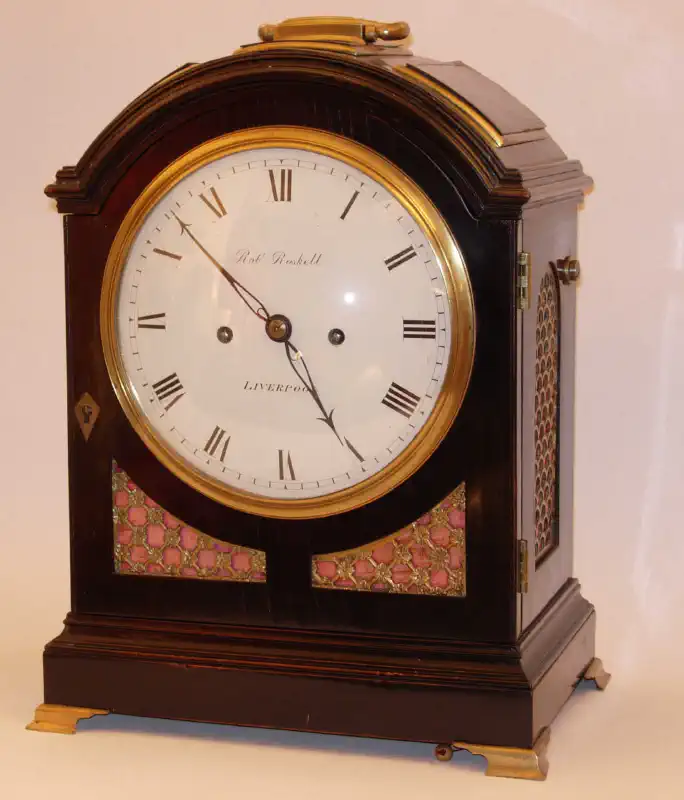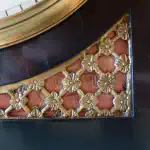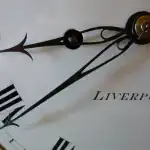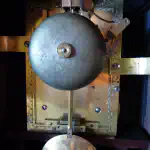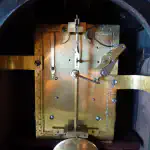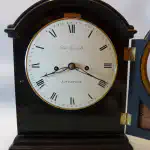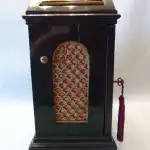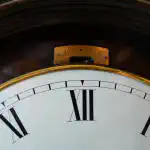Breakarch Bracket Clock by Robt Roskell (Liverpool) with movement signed by J Thwaites (London)
- Height:
- 35.5 cm
- Maker:
- Roskell/Thwaites
- Price:
- £4500
Case
Ebonized triple pad top with brass borders. Fish scale side frets with silk backing. Full opening door to reveal strike-silent control above XII. The front spandrels are a decorative brass rosette. A similar brass design is seen on the front of a 1795 clock pictured in Barder’s The Georgian Bracket Clock, 1993, p. 139, colour plate 19; and again on page 149, figure IV/97. The escutcheon is brass on the front and ivory on the rear door. The bezel and glasses are original to the clock.
Locks/Hardware
Working order
Dial
Prior to 2002, the dial had been altered to read “London” rather than “Liverpool”. Brass dial re-stored in 2002 by Andrew Nicholls, author of English Bracket and Mantel Clocks.
Hands
Original Thwaites hands. The hands are seen on a Thwaites clock in Nicholls, English Bracket and Mantel Clocks, p. 114.
Movement
Eight-day, twin fusee, original anchor escapement with trip pull-repeat. Movement is stamped J Thwaites on frontplate and stamped #2188 on the edge of the frontplate. Strike/silent switch on the front dial. A similar movement by Thwaites is seen in Andrew Nicholls’ English Bracket and Mantel Clocks, 1982, pp. 116-117 (Figures 56, 57, and 59). Backplate with edge engraving characteristic of Thwaites work around 1800.
Pendulum
Original brass/lead pendulum; heavy disc pendulum bob with unique pendulum fastener.
Date: 1800.
The movement is #2188 by Thwaites which dates this clock to 1800. The clock is triple numbered on the movement, dial and pendulum. Records from the Guildhall Library in London indicate that this clock was from the first order placed by Roskell to Thwaites.
Notes on the Maker
John Thwaites was a member of one of England’s most celebrated family of clockmakers whose production spanned five generations from the late 18th to the 20th centuries. Sons of Aynsworth Thwaites, John and Benjamin Thwaites, carried on their father’s business. Day ledgers at Guildhall library show that Thwaites provided work for Ellicott, Haley & Milner, Francis Perigal, Jesse Russel, Barraud & Lund, Desbois, Prior, Jamison, Spencer & Perkins, the Vulliamy’s, Hedge & sons, Fisher & sons, Field, Wightwick & Moss, Hawkins, and others.
John Thwaites made many famous clocks including the ones at St Paul’s Chapel, New York; Covent Garden; Scotland Yard; and St George’s Church, Grenada. Thwaites became freed of the Clockmakers Company in 1802 shortly after this clock was made. He went on to achieve the designation of Master. After his death, the firm was renamed Thwaites & Reed and became the longest continuous clock-making firm in history. For more information see: “A short biography of John Thwaites” by Geoffrey T E Buggins and F B M Devereux, Antiquarian Horology, June 1956, pp. 161-63.
Retailer Comments
Robert Roskell was based at 21 Church Street, Liverpool and also maintained premises in London. He was known to be working from 1798-1800 and made numerous high-quality watches signed “Roskell, Liverpool”. He was also a well-known retailer of clocks. He entered a partnership with John Roskell from 1805-1821 and took his son (Robert Jr) into partnership from 1825-1834 as Roskell and Son. As a retailer, Roskell sold all styles including bracket, longcase, carriage, and night-watchman’s clocks. There is a Simon Willard clock with “Roskell Liverpool” stamped on the rear plate (Horological Journal, July 1988, pp 220). Examples of Roskell watches can be seen at the Worshipful Company of Clockmakers’ collection at the Guildhall in London (item 475) and at Bury St Edmunds Manor House Museum. Roskell was known to purchase movements from Thwaites. Richard Rose lists 19 Thwaites clocks known to be commissioned by Roskell (Ronald E. Rose, English Dial Clocks, p. 247).
Roskell/Thwaites clocks are pictured in Andrew Nicholls’ English Bracket and Mantel Clocks, 1982, pp. 116-117 (Figures 56, 57, and 59). These pages show a movement similar to this clock. Nicholls also shows on page 114, Figure 54 a Thwaites clock with “typical Thwaites hands” which are identical to this clock. Other Thwaites movements are shown in Nicholls on page 121, figures 64-65. A Roskell/Thwaites clock is also featured in Barder’s The Georgian Bracket Clock, p. 185, fig VI/9. A later Roskell clock is shown in Barder’s book on p. 180, colour plate 33. Another Thwaites movement (#6179) is shown in Deryck Roberts, The Bracket Clock , p. 92, Figure 13.
Guildhall Library Ledgers
The Thwaites day ledgers at the Guildhall Library in London provide an account of early 19th C clock business. The clock is found in MS # 6788 volumes 3-4 at Guildhall. The very first order from Roskell occurred in November 1801 and is seen on page 321 of the Thwaites ledger. This order is for 7 bracket clocks including: “To a spring clock with 7” japanned plated with flat pendulum”. Based on the movement numbers recorded in the Guildhall ledger book, #2188 would have been one of these 7 sent to Roskell. This clock and 6 others sailed on the Aurora Pemberton from Cotton Warf in London and were scheduled for delivery to “No 64 Byrom Street, Liverpool”. This delivery location verifies that this clock was retailed from Liverpool.
Note: The clock is located in the USA. Free shipping within the continental United States.
Interested in this clock?
Send an email or leave a message and find out if it is still available!
